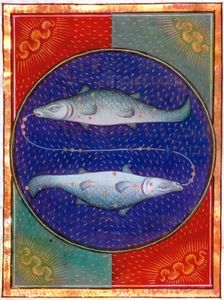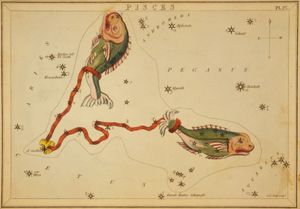Pisces
Our editors will review what you’ve submitted and determine whether to revise the article.
Pisces, (Latin: “Fishes”) in astronomy, zodiacal constellation in the northern sky between Aries and Aquarius, at about 1 hour right ascension and 15° north declination. The vernal equinox, the point where the Sun’s annual apparent path takes it north of the celestial equator and from which celestial longitude and right ascension are measured, lies in Pisces. The constellation contains only faint stars without any striking grouping; the brightest star, Eta Piscium, has a magnitude of 3.6.
In astrology, Pisces is the 12th sign of the zodiac, considered as governing the period from about February 19 to about March 20. Its representation as two fish tied together is usually related to the Greek myth of Aphrodite and Eros, who jumped into a river to escape the monster Typhon and changed into fish, or, alternatively, the two fish that carried them to safety.


